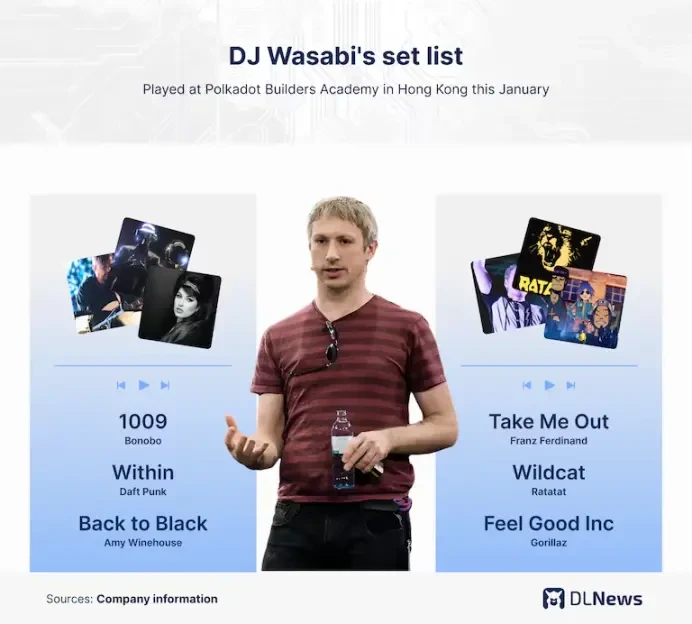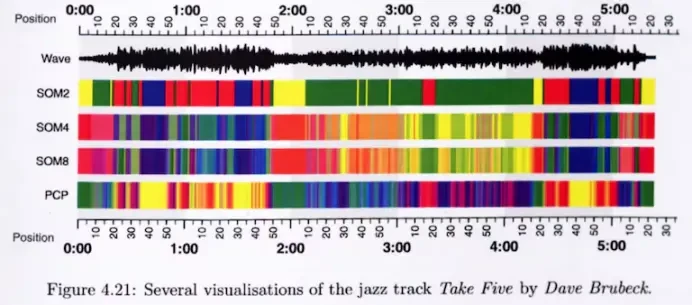Alors que Polkadot a plongé 50%, Gavin Wood a décidé de devenir DJ
Titre original: Gavin Wood on why Ethereum remains unchanged, Polkadot, and moonlighting as a DJ
Original article by Liam Kelly, DL News
Original translation: Lyric, ChainCatcher
Ethereum co-founder Gavin Wood was interviewed by DL News as Polkadot plummeted 50%.
After investing heavily in marketing, Polkadot is facing a backlash from users.
Gavin Wood talks about his other identity – as a DJ.
When Polkadot students finished up their five-week developer bootcamp in Hong Kong earlier this year, the party was on. During the graduation ceremony, members of the DeFi network saw a familiar face taking their place behind the DJ booth — Gavin Wood, co-founder of Polkadot and one of the masterminds of Ethereum.
After playing a key role in building the DeFi ecosystem for a decade, Gavin Wood, 44, is returning to his original passion, music. “If you see any articles about DJ Wasabi, that’s me,” Wood told DL News.
Finding new directions
The backdrop of his move is that Polkadot has been struggling to find a breakthrough.
In 2023, Parity Technologies, the company building the Polkadot network, laid off nearly a third of its 385 employees due to a lack of funds, according to employees. Polkadot was once one of the top ten cryptocurrency projects by token value. This year, its DOT token has fallen 50%, while ETH has risen 5% and rival Cardano has fallen 45%. And in July of this year, Polkadot faced more criticism, with critics slamming its decision to spend $87 million in the first half of the year. Nearly half of that was spent on marketing activities, including spending $400,000 to create an animated Polkadot logo on the cryptocurrency website CoinMarketCap. Its crazy that the Polkadot treasury wasted so much money on the wrong marketing, said Seun Lanlege, a former core developer at Parity, on X.

A Parity representative said that the marketing expenses stem from the project’s governance system. “Spending on marketing initiatives is a direct result of on-chain treasury spending as voted on by the community,” the representative told DL News.
With Wood’s transition to DJing, many in DeFi may wonder if he’s out of touch with his day job. Although Wood is the lead designer at Parity, he denies such concerns and downplays his role in the project. “My position is much lower,” he said.
“I am a scientist.”
Wood spoke to DL News at Funkhaus in Berlin during the Web3 Summit in August. Here, Wood shared his thoughts on blockchain design and technology. I want to experiment. Im a researcher, a scientist, an academic, and curiosity is my main driver here, he said. The biggest problem for Polkadot is that Ethereum has stagnated to some extent. In fact, Wood is good at pursuing unusual adventures. He is preparing to launch a personality system later this year, which will tattoo people with machine-generated QR code-like patterns.
Wood’s career began at the intersection of computer science and music.
In 2005, Wood completed a five-year doctoral program at York University, studying how computers hear music. He also created visual illustrations of the music that machines hear. His thesis showed what Dave Brubecks classic jazz piece Take Five would sound like to a computer.

Wood also worked on tech projects. He worked as a Microsoft researcher and taught geometry at a Catholic school in Italy. He sold lighting systems to nightclubs and bars in London, then tried to launch a Microsoft Word plug-in to automate the tedious work of lawyers. Soon after, he met Vitalik Buterin, Jeffrey Wilcke, and Charles Hoskinson, who were developing Ethereum. For Wood, Ethereum was essentially a weekend project he had been working on while developing a Word plug-in in the early 2010s.
Inventing Ethereum
He wrote one of the first Ethereum clients, a software application that allows developers to interact with the blockchain, in the C++ programming language. Wood helped invent Ethereums programming language, Solidity, and co-authored the Ethereum Yellow Paper, the first document that formally describes what the Ethereum network does and how it works. I also bring more of a design and engineering side to the table, which is like an almost artistic nature, I would say, he told DL News.
Although Wood has cemented his place in the cryptocurrency space by co-founding a blockchain system that has become a cornerstone of decentralized finance, he feels Ethereum lacks dynamism. “The Ethereum protocol has remained largely unchanged from the vision that Vitalik and I laid out in 2014,” he said.
In 2016, Wood struck out on his own and co-founded Polkadot with Robert Habermeier and Peter Czaban. The idea was to create a more efficient and affordable network to support dApps and smart contracts. The biggest problem for Polkadot is that Ethereum has stagnated to some extent, he said. I want to continue to develop. The project raised $144 million in an initial coin offering in 2017 – a cryptocurrency crowdfunding in which people invest real money in exchange for the networks native token. It began officially producing blocks in 2020. In the 2021 boom, its total value jumped to $54 billion, making DOT a top 10 cryptocurrency.
Improving the “cumbersome” cross-chain
He also launched a blockchain to solve a key bottleneck facing Ethereum. That is, layer 2 blockchains (mini blockchains that aggregate transactions into low-cost proofs that are then sent to Ethereum) are now common on Ethereum.
Polkadot introduced a similar design from day one, called parachains. Any project that chooses to build on Polkadot and launch its own parachain can easily interact with other Polkadot-based projects. For Ethereum-based layer 2 networks, users must interact with clunky cross-chain bridges to transfer funds between networks.
Wood said Polkadot is closer to Ethereum’s early vision. “Back when all fields were still blank, the second layer network was no longer a dream. The dream that Ethereum core developers pushed five years ago looks a bit like Polkadot.”
“I’m an experimenter.”
In April, he built on that vision with a Polkadot upgrade called JAM, or Join-Accumalate Machine. JAM will allow anyone to build a parachain, rather than having builders auction off one. The upgrade isn’t just technical. It comes as Polkadot tries to resurrect its 2021 glory days. But getting out of the rut that has plagued DeFi for so long won’t be easy. Employees said Parity not only needed to lay off a large number of employees due to excessive executive pay, but also handled the layoffs awkwardly. The company announced the layoffs a week before leaving for Mallorca, but didn’t reveal who was being laid off. One Parity employee called it “a surreal, bad joke.” Wood didn’t go on the beach vacation, which angered and confused many people. In July, Parity completed its reorganization and is currently hiring new employees. A Parity representative said its job postings list 11 open positions.
Now, Wood’s next project may attract attention again, which he calls “proof-of-ink.” At the Web3 Summit, Wood explained how the Polkadot blockchain can generate unique tattoo patterns. These patterns can prove that a person is who they say they are online without revealing other information. It seems to be able to deal with the so-called Sybil attack (where a user creates multiple identities) is a common problem in cryptocurrency.
Wood shows off a QR code on his bicep. He is working on other designs before launching in late 2024. “I really don’t want this to be seen as some kind of tattoo identification system.” The idea of tattooing identity markers on skin can provoke a backlash, especially in a place like Germany. Wood bristles at the suggestion.
“I spent a lot of time emphasizing that this is not about identification,” he told DL News. “This is about individuality. I spent a lot of time emphasizing privacy, and this is protected by strong encryption. I really don’t want people to say this is a tattoo recognition system, because that’s completely misleading.”
The project shows how Wood always follows his instincts, no matter where it leads him, from getting crypto-related tattoos to performing music as DJ Wasabi. “For me, unless it’s novel, it’s not worth doing,” he says. “I’m an experimenter.”
This article is sourced from the internet: As Polkadot plunged 50%, Gavin Wood decided to become a DJ
First, Federal Reserve Chairman Jerome Powell solemnly confirmed that the monetary easing cycle will begin next month. This heavy news is like a boulder thrown into a calm lake, causing huge waves in the financial field. For the cryptocurrency market, monetary easing means more liquidity, creating a more favorable environment for its development. Investor confidence has increased, and the rise in cryptocurrency prices has also gained strong momentum. Under the monetary easing policy, the amount of market funds has increased, and investors are actively looking for investment channels. Cryptocurrency has become the focus of many investors due to its unique technical advantages and potential high returns. With the continuous inflow of funds, the activity of the cryptocurrency market has increased significantly, and the scale of transactions is expected to expand…







